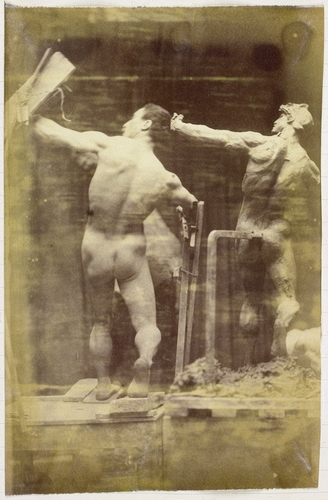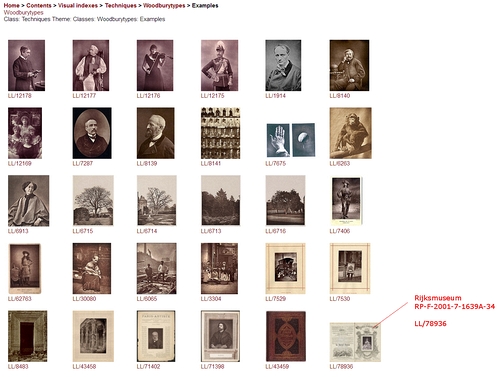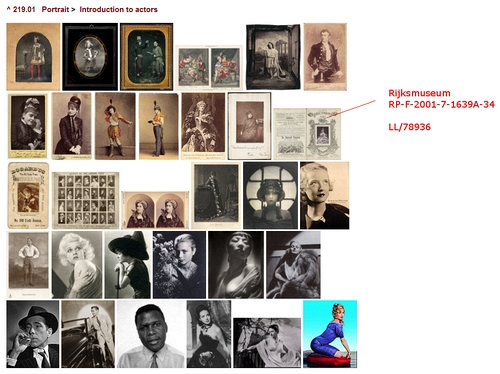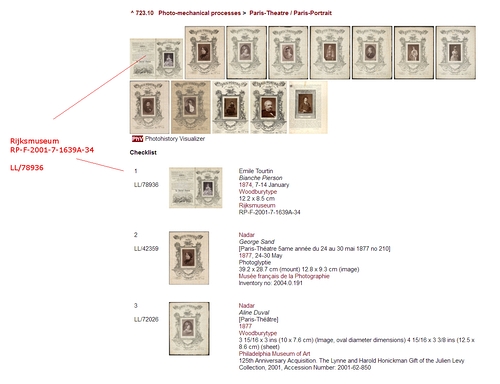| Newsletter for Collectors - Vol 11.8 | December 8, 2017 | | | Home • Photographers • Online Exhibitions
Contents • Alphabetical • Styles and movements • Articles
Visual Indexes • Galleries & Dealers • Timelines • Techniques
Library • Contact us Welcome to another Luminous-Lint Newsletter.
To all the subscribers to Luminous-Lint I'd like to say how much your support is appreciated. As you go through the Themes you will have noticed how quickly they are coming together with improved images and texts. You've been loyal friends over the years as Luminous-Lint has evolved into the immense resource it is now. I welcome your suggestions as research is never finished and all areas of Luminous-Lint are open to different approaches and fresh content.
The main point here though is just to say thank you and all the best for the holidays - Alan
"New Realities. Photography in the Nineteenth Century" at the Rijksmuseum in Amsterdam |

Jacques de Lalaing [Attributed to], "Study of a male nude model, seen on the back and with the hand in a scaffolding, next to a plaster model in exactly the same pose, in the studio of sculptor / painter Jacques de Lalaing", 1883-1914 (ca), Albumen print, Rijksmuseum, RP-F-2001-4-2
LL/78857
Click on the images to see larger versions
Unfortunately I wasn't able to visit the New Realities. Photography in the Nineteenth Century exhibition at the Rijksmuseum (17 June - 17 September 2017) and so I purchased the catalogue instead. The exhibition was described in press materials as:
... a major retrospective of 19th-century photography. Three hundred photos from the museum‘s own collection show just how varied photography was immediately after its invention in 1839. The exhibition includes portraits, nudes, cityscapes and travel photos, as well as scientific and commercial photography, and the first amateur snapshots.
The curators and writers - Mattie Boom, Hans Rooseboom, Saskia Asser, Steven Joseph and Martin Jürgens - have all provided insightful and well-illustrated texts that will take me time to go through in detail but here I want to concentrate on the photographs shown in the exhibition and explain how Luminous-Lint is indexing them to work out patterns within photohistory.
To date I've spent over two weeks going through the 330 page exhibition catalogue and I'm only at image 239 out of the 415 in the volume and I still have to read the text again.
So why does it take me so long to analyse a single catalogue?
"New Realities" - Setting the scene |
By the time the catalogue arrived Luminous-Lint already had 75,500 images related to photohistory online and these are used to illustrate hundreds of Themes and thousands of Visual Indexes throughout the website. Having said this there are considerable gaps for the following reasons:
- Images have not been found for a photographer included on Luminous-Lint
- The images available are of poor quality
- Images may come from diverse public collections, private collections, auction sites, estates etc etc but priority is given to institutional collections with accession numbers. This is important for future reseachers.
- A book or magazine with tipped-in photographs may be missing from the Luminous-Lint lists and even if it is known there may be no images of the pages.
- For some processes there are few surviving examples and so they are of particular interest.
So I'm continually seeking examples that fill in gaps.
"New Realities" - Examining a single image from the exhibition |
It is in these relationships that Luminous-Lint excels so let's look at the image below which is a Woodburytype of the actor Blanche Pierson tipped onto a printed magazine page. There are a host of ways that this single image from the "New Realities" exhibition could be used on Luminous-Lint to encourage different ways of thinking about photohistory.

Emile Tourtin, Blanche Pierson, 1874, 7-14 January, Woodburytype, Rijksmuseum, RP-F-2001-7-1639A-34
LL/78936
One way would be to consider the Woodburytype as a technical process and it is well described in the Graphics Atlas and other online resources. There are also texts such as the 2013 publication The Atlas of Analytical Signatures of Photographic Processes: Woodburytype, (Los Angeles: The Getty Conservation Institute) by Dusan Stulik and Art Kaplan. There is also the historical overview by Barret Oliver History of the Woodburytype (2007) and no doubt a host of other material readily available.
What makes Luminous-Lint different is that it includes complete sets of illustrations for the key publications including Woodburytypes along with examples from diverse collections.

Luminous-Lint screenshot showing a partial view of a Fragment showing "Woodburytypes" - [Created 6 December 2017]
LL/79071
On Luminous-Lint how actors have been photographed from the Daguerreotype and the salt print right through to the digital era is explained using around 400 examples and in the images below that accompany the opening paragraphs to the topic the following collection is shown. It uses 31 photographs of which the Rijksmuseum Woodburytype portrait of Blanche Pierson is one and you can see it within the collection.
The images selected are far from random and they are shown in a logical order to get a better sense of the topic under discussion.

Luminous-Lint screenshot showing a partial view of the photographs included in "Introduction to actors" - [Created 6 December 2017]
LL/79072
Whilst books on the famous photographers such as George Hurrell and John Kobal are common place there are other themes in photography that are not. Finding a well-sourced selection of how photographs were tipped-on to magazines, book covers, identity cards, business cards and souvenirs of communions and memorial cards is time consuming. There is no book on the subject and the visual evidence is scattered. Luminous-Lint includes extensive visual indexes to these rare survivals.

Luminous-Lint screenshot showing a partial view of the photographs included in "Paper objects that incorporate photographs" - [Created 6 December 2017]
LL/79073
Frequently the surviving examples are scattered between different institutions and it is only on Luminous-Lint that they are found together and organized. At the Rijksmuseum (The Netherlands) they have the Woodburytype portrait of Blanche Pierson and there are similar portraits from the Paris-Théâtre series in the collections at the Philadelphia Museum of Art (USA) and the Musée français de la Photographie (France).

Luminous-Lint screenshot showing a partial view of the photographs included in "Paris-Theatre / Paris-Portrait" - [Created 6 December 2017]
LL/79074
Truly understanding photohistory requires access not to a single photograph but to a swirling galaxy of meaningfully connected images that each add context.
The portrait shown at the New Realities exhibition is but one example and tens of thousands of similar ones could have been used. As the contextual relationships on Luminous-Lint are established so the writing comes into play to explain the patterns in words.
It takes many thousands of carefully selected photographs to start to understand the patterns.
Luminous-Lint continues to provide evolving pathways to improve understanding.
Free Trial of Luminous-Lint |
A FREE TRIAL for the website is currently available so send an email to alan@luminous-lint.com with your name and reasons for wanting to take a look and I'll set up a password for you.
  
Educational subscriptions |
As educators are now busy doing tweaks to their classes on photohistory and art history it is time to ensure that your subscription to Luminous-Lint has been confirmed. Please check with whoever manages subscriptions to digital resources to ensure all is well. If you are a professor, researcher or student requiring access to Luminous-Lint please contact your head of department or librarian.
If you need any assistance with curriculum planning or resources to supplement your courses send me an email.

Luminous-Lint is under continual revision and adding in some of the Rijksmuseum photographs has enhanced the following Themes. If you have suggestions for subjects that should be added please let me know.
Acropolis
Actors
Agricultural and pastoral
Albumen prints
Albums
American Civil War (1861-1865)
Animals
Anthropology and ethnology
Archaeology
Architecture
Art
Backgrounds and foregrounds
Backmarks
Back
Calotypists - Egypt
Calotypists - France
Carte de visite
Celebrities
Children
Christianity
Cityscapes - Urban
Collotypes
Columns, plinths and pedestals
Crimean War (1854-1856)
Daguerreotypes
Domesticated animals
Egypt
Emotions
Evidence
Family life
Fashion
Fauna
Flowers
Gelatin silver prints
Geology
Germany
Graffiti
Greece
Hand-painted photographs
India
Islamic architecture
Islam
Judaism
Lebanon
Leisure
Medical
Negatives
New York
Niagara Falls
Objects incorporating photographs
Painting on photographs
Paper objects
Paris
Photograph frames
Photographers
Photographing art - sculpture
Photography assimilated into popular culture
Portrait
Props
Publications, books, manuals, journals and magazines
Religious architecture
Remnants of the Ancient and Classical world
Royalty
Scientific experiments
Scientific
Second World War (1939-1945)
Self-portraits
Skeletons
Skulls
Social life of photographs
Sports and pastimes
Stereoscopes
Stereoviews, stereographs and stereocards
Still life
Syria - Syrian Arab Republic
The Holocaust (1933-1945)
Tintypes
Tipped-in photographs in books
Tipped-in photographs in magazines and journals
Typologies
Urban life
Viewers
War
Water and waterfalls
Women photographers
Woodburytypes
X-rays
|
|
John Demos (1944, 17 January - ) was born - Greece, Thessaloniki. Portraits of Greece and the rituals that are carried out. His book ‘Shadows of Silence‘ received excellent reviews.
Herbert G. French (1872, 17 January - 1942, 25 June) was born - US, KN, Covington. American photographer whose work was published in Camera Work in 1909.
Izis (1911, 17 January - 1980, 16 May) was born - Lithuania, Mariampolé. Lithuanian-born photographer, active in France.
William Eddowes (1827, 10 September - 1880, 17 January) died - Ireland, Sandymount.
Sir Francis Galton (1822, 16 February - 1911, 17 January) died - England, Surrey, Haslemere. British polymath who used photography to better understand scientific principles.
William James Mullins (1860, 21 August - 1917, 17 January) died - US, PA, Pittsburgh.
Eugene Piot (1812, 11 November - 1890, 17 January) died. Early French antiquarian, art collector and photographer who travelled in Greece and Italy and had his portrait taken by Gustave Le Gray. |
| |
|

